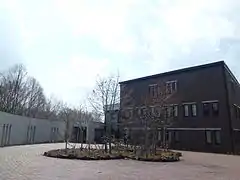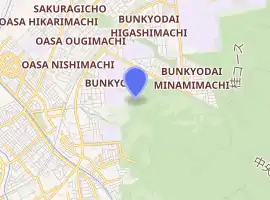Hokkaido Archaeological Operations Center
Hokkaido Archaeological Operations Center (北海道立埋蔵文化財センター, Hokkaidō-ritsu Maizō Bunkazai Sentaa) opened in Ebetsu, Hokkaidō, Japan in 1999. Its aim is to protect, preserve, and utilize buried cultural properties.[1][2]
| Hokkaido Archaeological Operations Center | |
|---|---|
北海道立埋蔵文化財センター | |
 | |

| |
| General information | |
| Address | 685-1 Nishi-nopporo |
| Town or city | Ebetsu, Hokkaidō |
| Country | Japan |
| Coordinates | 43°03′36″N 141°29′40″E |
| Opened | 1 April 1999 |
| Website | |
| Official website | |
History
In December 2017, researchers from the Hokkaido Archaeological Operations Center announced the discovery of the oldest ancient stone with a human face painted on it (12x13cm), estimating its creation date between 2,500 and 1,000 B.C.[3][4]
Description
The exhibition hall features two Important Cultural Properties: an earthen Jōmon mask from the Mamachi Site and artefacts excavated from the Bibi 8 Site.[5][6]
Collection
See also
- List of Cultural Properties of Japan - archaeological materials (Hokkaidō)
- List of Cultural Properties of Japan - historical materials (Hokkaidō)
- List of Historic Sites of Japan (Hokkaidō)
- Hokkaido Museum
- Ainu culture
References
- "Hokkaido Archaeological Operations Center" (PDF). Hokkaido Archaeological Operations Center. Retrieved 11 November 2016.
- 北海道立埋蔵文化財センター [Hokkaido Archaeological Operations Center] (in Japanese). Hokkaido Prefectural Board of Education. Retrieved 11 November 2016.
- Kastalia Medrano, World's first-known ancient stone with painted face discovered, looks exactly like a slice of pizza, Newsweek.com, 21 December 2017
- Theodoros Karasavvas, 4,300-Year-Old First Face Offers a Glimpse of Ancient Japanese Culture, Ancient-origins.net, 19 December 2017
- 土面/北海道千歳市真々地町ママチ遺跡第三一〇号土壙墓出土 [Earthen Mask Excavated from Mamachi Site burial 310, Mamachi-chō, Chitose, Hokkaido] (in Japanese). Agency for Cultural Affairs. Retrieved 11 November 2016.
- 北海道美々8遺跡出土品 [Artefacts Excavated from the Bibi 8 Site, Hokkaido] (in Japanese). Agency for Cultural Affairs. Retrieved 11 November 2016.
- The Prayers and Hearts of the Jomon People, Akarenga-h.jp
- Giant at the Archaeological Center, Shiinatakehito.com
- Koji Chihara, Wood culture in pre-modern Hokkaido Island: a comparative study between Central Japan, Lasy.gov.pl, 2019
External links
- (in Japanese) Official website
- (in English) Hokkaido Archaeological Operations Center
This article is issued from Wikipedia. The text is licensed under Creative Commons - Attribution - Sharealike. Additional terms may apply for the media files.